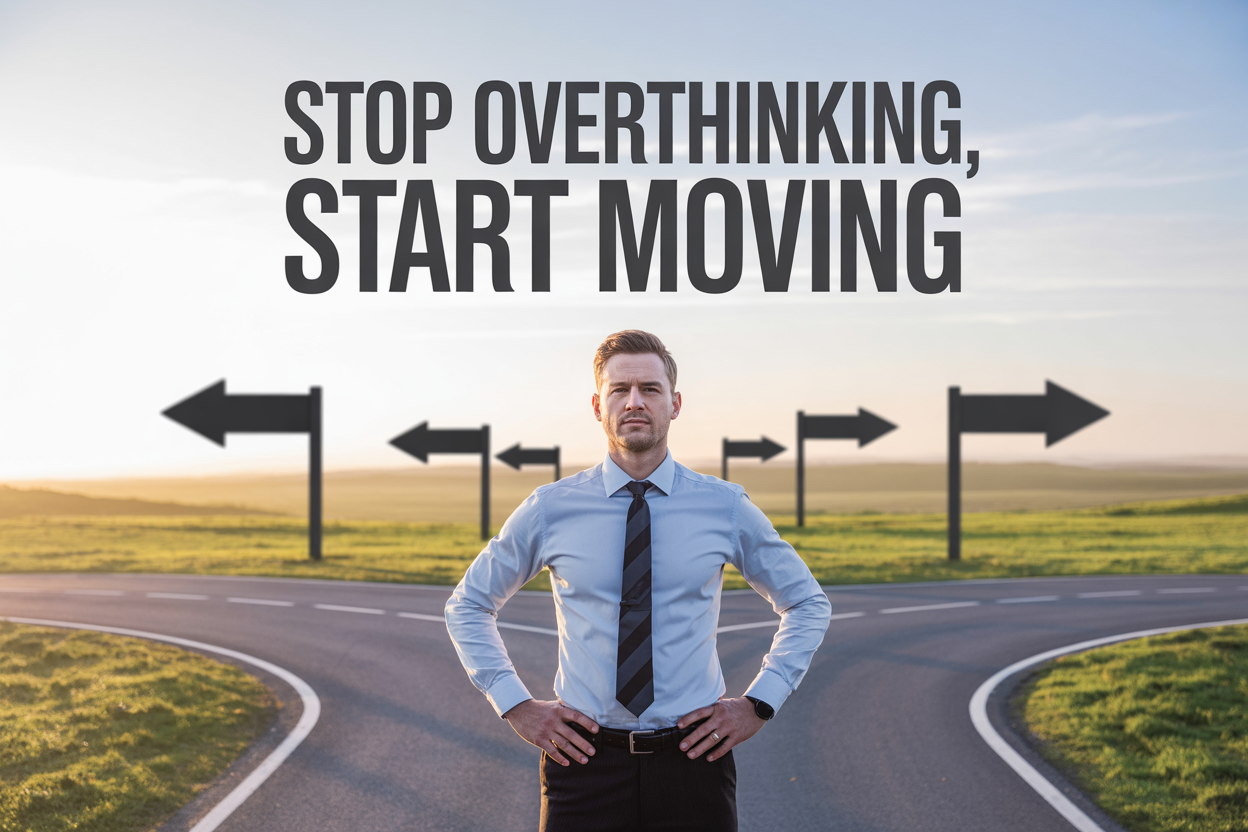Are you stuck in an endless loop of “what if” scenarios, analyzing every possible outcome until you’re too exhausted to actually choose? You’re not alone. Millions of people struggle with overthinking, turning simple choices into overwhelming mental marathons that leave them paralyzed and frustrated.
This guide is for anyone who’s tired of being their own worst enemy when it comes to making decisions—whether you’re a professional facing career crossroads, an entrepreneur launching a business, or someone simply trying to move forward in life without second-guessing every step.
We’ll explore why overthinking costs you more than bad decisions ever could and dive into the science behind effective decision making that successful people use daily. You’ll discover proven strategies to stop overthinking in its tracks and build unshakeable decision making confidence. Most importantly, you’ll learn how to transform your choices into real forward momentum instead of staying stuck in analysis paralysis.
Ready to break free from the overthinking trap and start making decisions that actually move your life forward? Let’s jump in.
Understanding the Cost of Overthinking

How Analysis Paralysis Destroys Opportunities
Every minute spent weighing the perfect decision is a minute your competitors aren’t wasting. Analysis paralysis hits when you become so focused on gathering information and considering every possible angle that you miss the window of opportunity entirely. Picture this: you spot an amazing job opening that aligns perfectly with your career goals. Instead of applying within the first few days, you spend weeks crafting the “perfect” resume, researching every detail about the company, and questioning whether you’re truly qualified. By the time you finally submit your application, the position has been filled by someone who acted quickly with a good-enough application.
This pattern repeats across all areas of life. Real estate investors lose out on profitable properties while they analyze market trends endlessly. Entrepreneurs watch competitors launch similar products while they’re still tweaking their business plans. The irony is that most opportunities have expiration dates that don’t wait for your perfect analysis to conclude. Decision making requires accepting that you’ll never have all the information you think you need, and that’s perfectly fine.
The most successful people understand that taking imperfect action beats perfect inaction every time. They recognize that opportunities are like buses – if you miss one, another will come, but only if you’re willing to step up when it arrives.
The Mental Energy Drain of Endless Deliberation
Your brain treats decision making like a muscle, and overthinking is the equivalent of doing mental marathons without rest. Psychologists call this “decision fatigue” – the deteriorating quality of decisions made after a long session of decision making. When you spend hours deliberating over relatively simple choices, you’re burning through your mental resources that could be better used for genuinely important decisions.
Think about how exhausted you feel after spending an entire afternoon trying to choose between two job offers, weighing salary against work-life balance, company culture against growth opportunities. That mental exhaustion isn’t just in your head – it’s measurable brain drain that affects your ability to focus, be creative, and make sound judgments for the rest of the day.
The hidden cost goes beyond immediate fatigue. Chronic overthinking creates a negative feedback loop where you start avoiding decisions altogether because the process feels so overwhelming. This avoidance then creates more stress as undecided issues pile up, creating what researchers call “cognitive load” – the mental space occupied by unfinished business.
Smart decision makers protect their mental energy by:
- Setting time limits for decisions
- Using simple frameworks to evaluate options
- Accepting that most decisions are reversible
- Focusing their analytical energy on high-impact choices only
Why Perfect Decisions Don’t Exist
The pursuit of the perfect decision is like chasing a unicorn – magical in theory, impossible in reality. Every choice involves trade-offs, and there’s always information you don’t have access to or future circumstances you can’t predict. The stock market crash nobody saw coming, the pandemic that changed everything, the technology that made your careful planning obsolete overnight – these remind us that even the most thorough analysis can’t account for every variable.
What separates effective decision makers from chronic overthinkers is their relationship with uncertainty. Instead of viewing unknown factors as problems to solve, they see them as inherent parts of any decision making process. They focus on making decisions that are directionally correct rather than perfectly optimized.
Consider successful entrepreneurs who launched businesses during economic downturns or tech leaders who pivoted their companies when their original plans didn’t work out. They didn’t have perfect information, but they had enough to move forward and adapt along the way. This approach – sometimes called “satisficing” rather than maximizing – leads to better outcomes because it allows for course correction and learning through action.
The most liberating realization about decision making is that you don’t need to be right all the time. You just need to be right enough to make progress, then be willing to adjust as you learn more. Perfect decisions are the enemy of good decisions, and good decisions made quickly almost always beat perfect decisions made too late.
The Science Behind Effective Decision Making

How Your Brain Processes Choices
Your brain operates like a sophisticated prediction machine when making decisions. The prefrontal cortex analyzes options and weighs consequences, while the limbic system evaluates emotional significance. When you overthink decisions, these systems can become overloaded, creating what neuroscientists call “decision fatigue.”
Research shows that effective decision making involves a delicate balance between analytical thinking and pattern recognition. Your brain naturally seeks to minimize cognitive load by relying on mental shortcuts called heuristics. These shortcuts aren’t flaws – they’re evolutionary advantages that helped our ancestors make quick survival decisions.
The key insight for better decision making is understanding that your brain performs best when given clear parameters and reasonable time constraints. Without boundaries, the analytical mind continues processing indefinitely, often diminishing decision quality rather than improving it.
The 80/20 Rule for Decision Quality
The Pareto Principle reveals a powerful truth about effective decision making: 80% of your decision quality comes from the first 20% of information you gather. This means that once you’ve collected basic facts and considered primary options, additional research yields rapidly diminishing returns.
Smart decision makers recognize when they’ve reached the “good enough” threshold. This doesn’t mean settling for mediocrity – it means understanding that perfect information rarely exists, and waiting for it often costs more than making a solid decision with available data.
Consider these guidelines for applying the 80/20 rule:
- Set information limits: Decide upfront how much research you’ll conduct
- Time-box decisions: Give yourself specific deadlines for different decision types
- Identify must-have vs. nice-to-have information: Focus on critical data first
- Track decision outcomes: Learn which information actually influenced your best decisions
Why Gut Instincts Matter More Than You Think
Your intuition processes vast amounts of subconscious information that your conscious mind cannot handle simultaneously. This “thin-slice” decision making taps into pattern recognition systems built from years of experience and learning.
Malcolm Gladwell’s research on rapid cognition demonstrates that initial impressions, formed within seconds, often prove remarkably accurate. Your gut instincts aren’t random feelings – they’re sophisticated computational processes happening below conscious awareness.
The most successful decision makers learn to integrate analytical thinking with intuitive insights. They use logic to gather information and structure problems, then trust their instincts to synthesize complex factors into actionable choices.
However, gut instincts work best within your areas of expertise. A chess master’s intuition about board positions is highly reliable, while their gut feelings about stock picks might not be. Build decision making confidence by recognizing where your experience creates trustworthy intuitive judgment.
The Diminishing Returns of Extra Information
Information gathering follows a predictable curve: initial research provides massive value, but each additional piece of data contributes less to decision quality. Beyond a certain point, more information actually hurts decision making by:
- Creating analysis paralysis: Too many options overwhelm your processing capacity
- Introducing contradictory data: Conflicting information breeds doubt and hesitation
- Delaying action: Time spent researching is time not spent implementing
- Increasing anxiety: More information often reveals more potential problems
The solution isn’t to ignore information – it’s to recognize the optimal stopping point. Professional decision makers in fields like emergency medicine and military strategy excel because they’ve learned to act decisively with incomplete information.
| Decision Type | Optimal Research Time | Information Threshold |
|---|---|---|
| Routine/Low Stakes | 5-15 minutes | Basic facts only |
| Important/Medium Stakes | 1-3 hours | Key factors + 2-3 options |
| Critical/High Stakes | 1-3 days | Comprehensive but time-limited |
Stop overthinking by establishing decision criteria upfront, gathering information systematically, and setting firm deadlines for action. Your brain craves certainty, but successful people learn to move forward in life despite uncertainty.
Proven Strategies to Stop Overthinking

Set Clear Decision Deadlines
Nothing kills effective decision making faster than leaving choices open-ended. Without a deadline, your brain treats every decision as if you have unlimited time to weigh options, which leads straight to overthinking and paralysis by analysis.
Create artificial urgency by setting specific deadlines for your decisions. Whether you’re choosing between job offers, planning a career change, or deciding on a major purchase, give yourself a concrete timeframe. For smaller decisions, allow 24-48 hours. For bigger life choices, set a deadline of 1-2 weeks maximum.
Write down your deadline and stick to it. When the time arrives, make the best decision with the information you have. Remember, most decisions aren’t permanent and can be adjusted later if needed. The cost of delaying often outweighs the risk of making an imperfect choice.
Use the Two-List Method for Clarity
Mental clutter makes decision making exponentially harder. The Two-List Method cuts through confusion by forcing you to organize your thoughts on paper rather than letting them swirl endlessly in your head.
Here’s how it works: Create two columns on a piece of paper or document. Label one “Reasons For” and the other “Reasons Against.” List every factor that comes to mind under the appropriate column. Don’t filter or judge initially – just brain dump everything.
After you’ve exhausted your thoughts, review both lists. Cross out items that are based on fear rather than facts. Highlight the three most important factors in each column. This visual approach helps you see patterns and identify what truly matters versus what’s just noise in your decision making process.
| Decision Factor | Weight | For | Against |
|---|---|---|---|
| Financial Impact | High | ✓ | |
| Time Investment | Medium | ✓ | |
| Personal Growth | High | ✓ | |
| Family Considerations | High | ✓ |
Practice the 10-10-10 Rule for Perspective
Overthinking often stems from losing perspective about the real impact of your choices. The 10-10-10 Rule provides a simple framework to evaluate decisions across different time horizons and stop overthinking about scenarios that won’t matter long-term.
Ask yourself three questions about each option:
- How will I feel about this decision in 10 minutes?
- How will I feel about this decision in 10 months?
- How will I feel about this decision in 10 years?
This technique reveals whether you’re agonizing over something that will barely register on your life’s timeline. Many decisions that feel monumental in the moment become insignificant when viewed through this lens. Use this rule to identify which choices deserve deep consideration and which ones you should make quickly and move forward.
The 10-10-10 Rule also helps you avoid decision making strategies based purely on immediate emotions or distant fears. It creates balance between short-term consequences and long-term vision, leading to more confident choices that align with your overall direction in life.
Building Your Decision-Making Confidence

Start with Low-Stakes Choices to Build Momentum
Building decision-making confidence works like building muscle – you start light and gradually increase the weight. Begin with small, reversible choices that won’t dramatically impact your life. Pick your lunch without scrolling through the menu three times, choose your weekend activity within five minutes, or select your morning outfit quickly.
These micro-decisions create a positive feedback loop. Each quick choice reinforces your ability to decide and move forward. When you successfully make ten small decisions without endless deliberation, you prove to yourself that most choices aren’t as critical as your overthinking mind believes.
Practice the “good enough” principle with these low-stakes decisions. Your morning coffee choice doesn’t need to be perfect – it just needs to be made. This approach trains your brain to distinguish between decisions that deserve careful thought and those that simply need action.
Learn from Quick Decisions Without Regret
Quick decisions often turn out better than we expect. When you make a fast choice and it doesn’t go perfectly, resist the urge to beat yourself up. Instead, ask yourself: “Was this outcome actually worse than spending three hours agonizing over the decision?”
Most of the time, you’ll discover that imperfect action beats perfect inaction. That restaurant you picked on impulse might not have been amazing, but you enjoyed a nice evening instead of spending an hour researching reviews online.
Document these experiences in a simple decision journal. Note the choice you made, how long you spent deciding, and the actual outcome versus what you feared might happen. This concrete evidence helps rewire your brain’s risk assessment and builds confidence in your natural decision-making abilities.
Develop Your Personal Decision Framework
Create a simple framework that guides your decision-making process without getting bogged down in analysis paralysis. Start with three key questions:
- What’s the worst realistic outcome?
- Can I reverse or adjust this decision later?
- What would I tell my best friend to do?
For bigger decisions, expand your framework to include your core values and long-term goals. But keep it simple – overcomplicated frameworks just become another excuse to overthink.
Consider using time limits based on decision importance. Give yourself 2 minutes for daily choices, 2 days for moderate decisions, and 2 weeks maximum for major life changes. This prevents minor decisions from expanding to fill unlimited time.
Some people find it helpful to assign dollar values to decisions. Spending under $20? Decide in 2 minutes. Under $200? Take a day. This quantifiable approach removes emotion from the decision-making timeline.
Create Accountability Systems for Follow-Through
Strong decision-making confidence comes from following through on your choices. Create systems that make it harder to second-guess yourself after deciding. Share important decisions with trusted friends or family members who can remind you of your reasoning when doubt creeps in.
Set implementation intentions for your decisions. Instead of “I’ll start exercising,” commit to “I’ll go to the gym Tuesday at 6 PM.” Specific plans make follow-through more likely and reduce opportunities for endless re-evaluation.
Use the “decision deadlines” approach. Once you’ve made a choice, implement it within 48 hours when possible. The longer you wait, the more time doubt has to grow. Quick implementation builds momentum and proves your decisions work in the real world.
Track your decision-making wins in a simple log. Record choices you made quickly and stuck with, noting the positive outcomes. This running list becomes powerful evidence of your decision-making capabilities during moments of self-doubt.
Consider finding an accountability partner who’s also working on decision-making confidence. Check in weekly about the choices you’ve made and how you’re following through. Sometimes external perspective helps you see that your decisions are more sound than your inner critic suggests.
Transforming Decisions into Forward Momentum

Turn Choices into Immediate Action Steps
The biggest gap between making a decision and seeing results lies in the transition from choice to action. Once you’ve committed to a path, break it down into the smallest possible steps you can take right now. This approach transforms abstract decisions into concrete behaviors that create immediate forward momentum.
Start with the “two-minute rule” – identify one action related to your decision that takes less than two minutes to complete. Made a decision to change careers? Your first step might be updating your LinkedIn headline. Decided to improve your health? Walk to the end of your street and back. These micro-actions create psychological momentum and prove to yourself that you’re someone who follows through on decisions.
Create action hierarchies by listing three immediate steps, three short-term steps (within a week), and three medium-term steps (within a month). This prevents the common trap of making grand decisions without practical implementation plans. When you can see the path from decision to execution laid out clearly, your brain stops questioning the choice and starts focusing on the doing.
Document your action steps in a visible place. Whether it’s a phone app, sticky notes, or a notebook, external accountability systems keep your decisions alive beyond the initial moment of choice.
Use the Power of Committed Implementation
Commitment transforms wishful thinking into inevitable outcomes. The difference between people who successfully execute their decisions and those who don’t lies in their approach to commitment. True commitment involves creating systems that make backing out more difficult than moving forward.
Share your decision with someone who will ask you about your progress. This external accountability creates healthy pressure that helps you push through resistance when motivation wanes. Choose someone who supports your growth but won’t let you off the hook easily.
Set implementation intentions using “if-then” statements. Research shows this strategy dramatically improves follow-through rates. Instead of saying “I’ll start exercising,” say “If it’s Monday, Wednesday, or Friday morning, then I’ll put on my workout clothes immediately after my morning coffee.” These pre-planned responses eliminate decision fatigue and create automatic behaviors.
Establish consequences for both action and inaction. Reward yourself for following through on commitments, but also create meaningful costs for backing down. This might involve donating money to a cause you oppose or publicly acknowledging when you’ve failed to honor your commitments.
Track your implementation rate over time. Keep a simple record of promises made versus promises kept. This data helps you understand your patterns and adjust your commitment strategies accordingly.
Adjust Course Without Starting Over
Flexibility within commitment prevents perfectionism from derailing your progress. The goal isn’t to execute your original decision flawlessly forever, but to maintain forward momentum while adapting to new information and changing circumstances.
Distinguish between adjusting tactics and abandoning strategy. If your decision was to build a consulting business, switching from LinkedIn outreach to networking events represents a tactical adjustment. Abandoning the consulting idea entirely to start a food truck represents a strategic pivot that should be evaluated more carefully.
Schedule regular review sessions to assess your progress and make necessary adjustments. Weekly or monthly check-ins help you stay responsive without becoming reactive. Ask yourself: What’s working? What isn’t? What would I do differently if I were starting fresh with what I know now?
Use the “minimum viable progress” approach when obstacles arise. If your original plan becomes impossible, identify the smallest possible step that still moves you toward your goal. Can’t attend the networking event you planned? Send three LinkedIn messages instead. Can’t work out for an hour? Do ten pushups.
Remember that course corrections often lead to better outcomes than rigid adherence to original plans. Many successful ventures emerged from pivots rather than perfect execution of initial decisions. The key is distinguishing between productive adaptation and avoidance-based abandonment.

Overthinking might feel like you’re being thorough, but it’s actually costing you valuable time, energy, and opportunities. When you understand how your brain works and apply the right strategies, you can break free from analysis paralysis and start making decisions with confidence. The key is accepting that perfect decisions don’t exist – good enough decisions that you act on will always beat perfect decisions that never happen.
Your future self will thank you for every decision you make today, even the imperfect ones. Stop waiting for more information, more time, or more certainty. Trust your judgment, use the tools you’ve learned, and take that first step forward. The momentum you create from one decision will naturally lead to the next, building the life you actually want instead of the one you’re just thinking about.









